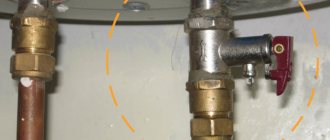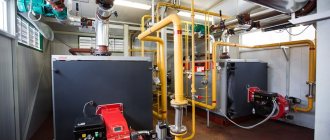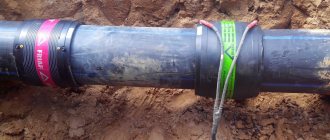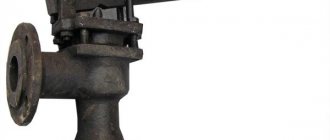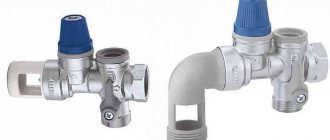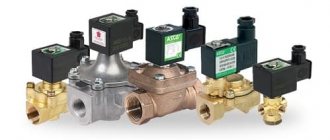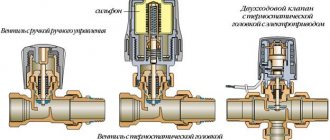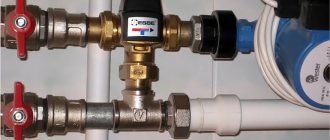Purpose of the thermostatic valve
A thermostatic mixing valve, the price of which is 1,500 rubles, is a control device built into pipeline systems through which a liquid working medium is transported. If such a valve is installed in the design of the heating network, it will act on the principle of a mixer tap that mixes or switches flows.
Installation of such a crane allows you to cope with many problems, including:
- the need to redirect flows;
- the possibility of obtaining a jet with a constant temperature;
- problem of achieving the desired water temperature.
Different flows can come from different pipelines. The thermostatic valve performs the function of their redirection. With its help, the working fluid acquires a certain temperature by mixing cold and hot flow. A jet with a certain temperature is obtained using the dynamic redirection method.
Brief overview of the thermostatic mixing valve
The principle of operation of an autonomous heating system is that a working fluid constantly circulates through a closed circuit of a gas, liquid or solid fuel heating boiler, which transfers heat from the boiler to water radiators and distributes it evenly throughout the house. The same principle applies to the hot water supply system, only in this case it operates not in a closed circuit, but in a flow-through circuit, transferring heated water from the boiler to household plumbing fixtures.
In order to constantly maintain the temperature of water or other coolant in the system at a given level, an automatic device is used, which is called a thermostatic mixing valve for hot water supply and autonomous heating systems.
Connection diagram to the DHW system.
Basic functions of a thermostatic valve
The main purpose of a three-way thermostatic mixing device is to stably maintain the set temperature of the working fluid (water, antifreeze or other coolant) in autonomous heating and hot water supply systems.
Compliance with this condition when installing home utilities with your own hands helps solve a number of the following problems:
- The water in the DHW heating circuit can heat up to a temperature of +95 °C , which can lead to burns when opening consumer taps, and if there is a mixing valve, its temperature will have a constant value of no higher than +60 °C.
- Reduced temperature in the return circuit of the heating system can lead to the formation of condensation , and the installation of a three-way valve allows the water temperature in the return line to be increased to the recommended value.
- Mixing cold water into the hot water supply path directly in front of consumers allows you to save up to 25% of fuel or electricity that is spent on heating.
The photo shows a diagram of the connection to the heating system.
Advice! In addition to basic radiator heating and hot water supply for domestic needs, it is also advisable to use such devices in home underfloor heating systems.
Specifications
In normal mode, a thermostatic distributor can operate trouble-free for several years, properly performing its functions, and there are several models of these devices, which differ from each other in their parameters and the type of threaded connection for connection to the heating or water supply water circuit.
According to the operating instructions, depending on the specific model, modern three-way thermostatic mixing valves have the following technical characteristics:
- The device body is made of high-quality brass or bronze, which has a chromium-nickel protective and decorative galvanic coating.
- The maximum permissible pressure in the heating or hot water supply system is 10 kg/cm².
- The maximum permissible coolant temperature is: for heating boilers – 95° C; for solar panels and solar water heating stations – 110 °C.
- The range of manual adjustment of the temperature of the working fluid, depending on the specific model, can be in the following ranges from 20 to 60 °C.
- The type of threaded connection, depending on the model, can be of the following types: Rp3/4”; G3/4"; G1; G1 1/2”.
- The nominal throughput in operating mode, accordingly, can range from 1.6 to 2.5 m³/hour.
Cold water mixing unit in the plumbing panel.
Advice! At first glance, the price of this device may seem quite high, but given the savings in fuel and electricity consumption, the cost of its purchase can be recouped within 1-2 years.
Internal structure and principle of operation
Structurally, the thermostatic mixing valve is a cast metal body made of brass or bronze, which has three threaded outlets for connection to the pipeline. A heat-sensitive element, a movable rod, and a spring-loaded valve are installed inside, which can be hermetically adjacent to one of two seat seats.
Sectional design of a three-way valve.
The general principle of operation of a thermostatic mixing valve is that the temperature-sensitive element, under the influence of heat, increases in volume and moves the movable rod on which the shut-off valve is installed.
- When hot water enters from the lower pipe, it flows freely into the right pipe until the working element warms up to a certain temperature.
- After heating the temperature-sensitive element above the set temperature, it begins to expand and moves the valve down, thereby shutting off the supply of hot water from the bottom pipe and opening the supply of cold water from the left pipe.
- After adding cold water and equalizing the temperature, the body of the demolition working element is compressed, and the valve plate, under the influence of the spring, takes its previous position.
General structure and explanatory image to describe the operating principle.
Note! In a heating boiler return circuit system, the mixing valve is installed in the reverse order: when the coolant is cooled, hot water from the direct supply pipeline is mixed into the pipeline.
Valve device
The most often described product is in the form of a tee, which is made of bronze or brass. There is an adjusting washer on top, under which there is a heat-sensitive element. It acts on the working rod, which is part of the housing. The cone is located inside, on the rod, the first of which fits into the seat as tightly as possible.
In order to understand the principle by which thermostatic mixing valves work, you need to familiarize yourself with the design, which includes:
- frame;
- cone;
- saddle;
- stuffing box seal;
- valve insert;
- valve stem;
- unloading chamber.
Three-way valve device
Structurally, it consists of two connected two-way valves in one body. But unlike them, the hot water flow is not completely blocked, but the intensity of its passage is regulated. Due to this, the temperature of the hot water changes.
- Valve main parts:
- frame;
- rod with locking washer or metal ball;
- fastening nuts (couplings).
Valves with a stem allow automated control via an electromechanical drive. This allows you to automatically regulate the water temperature. The principle of operation of a ball valve can be compared to a kitchen faucet. They are used only in manually operated valves.
Please note: when choosing a faucet, you should pay attention to the material from which the body is made. Brass is lighter and more durable compared to cast iron.
To understand what the thermo-mixing three-way valve of the most common saddle type consists of and how it works, you should study the diagram below.
Inside the brass body with three nozzles, 3 chambers are arranged using the casting method, the passages between which are blocked by poppet valves. They are fixed on one axis - a rod coming out of the body on the fourth side.
Types of Thermostatic Mixing Valves
- They differ in the way they are controlled. Valves can be roughly divided into:
- with manual control;
- with thermal head;
- with electric drive;
- hydraulic;
- pneumatic.
In a private home, an electric valve would be most acceptable. Sensors installed inside issue a command through the controller to the drive if the controlled water parameters change.
As a result, it becomes warmer, or vice versa, cooler. The thermo-mixing effect occurs automatically. It does not matter which boiler is installed in the system - gas or solid fuel.
If it is not possible to install an adjustable valve in the heating system, then the best solution in this case would be a valve with a thermal head.
Principle of operation
The coolant circulates through the right and front pipes until its temperature rises or is lower and corresponds to a certain value. The operating principle and task of the valve is to maintain the water temperature within certain parameters. When they no longer meet the limits, the external drive begins to act on the rod. When it moves, a cone emerges from the seat and opens a communication between the channels. This process will continue until the front inlet pipe is closed. This is true if the coolant temperature parameters do not change.
The principle of operation in the heating system - how the device works
To put it simply, the operating principle of a three-way valve is to mix water heated to different temperatures. At the same time, fuel savings are achieved, and the boiler operates more efficiently and is not subjected to unnecessary loads.
While the water circulates through the heating pipes, it gradually cools down. Therefore, answering the question why a three-way valve is needed for heating, let’s say that it allows you to dilute cold and hot water so that it is reheated by the boiler more quickly and easily.
In addition, hot water flows are distributed throughout the system, and in order not to do this manually, an electric drive is installed. It automatically controls the flow, controlling the degree of heating of the coolant. The durability and efficiency of the heating system depends on the quality of this part.
Operating principle of valves with another device
Thermostatic mixing valves sometimes have a slightly different internal mechanism than described. In this case, the design is similar to a ball valve. Instead of a cone and a seat, such a valve has a ball with a selection of the desired shape. To redistribute water flows in such structures, rotation occurs rather than pressing on the rod.
If the equipment has a ball element, then it should not have impressive throughput. It is used in domestic heating systems. There is another type of mechanism in which a sector, rather than a ball, is located on the rod; its working part partially or completely blocks one or two flows.
Types of valves by type of actuator
Thermostatic mixing valves come in several varieties. The first has the form of a thermostatic drive that acts on the rod, which is made possible by the liquid medium, because it is sensitive to temperature fluctuations. Household mixing valves with a small diameter have this type of actuator; it can be easily removed to install another one.
The thermostatic mixing valve, the principle of operation of which was described above, can sometimes be presented in another version, in which, instead of the standard drive, control is carried out by a thermostatic head, which has its own sensitive element. It reacts to the temperature of the external environment. To regulate the temperature of the coolant, the valve is equipped with a remote sensor. It is located in the water pipeline and is connected to the drive by a capillary tube. Regulation according to this principle is more accurate.
The home heating system can be supplemented with a valve whose stem is actu- ated by an electric actuator and is controlled by a controller. This variety is the third version of the thermostatic valve. Electrical sensors are also called temperature transducers. They monitor water parameters and report changes to the controller; the operation of the electric valve depends on it. This adjustment method is as accurate as possible and is the most common.
The home heating system is sometimes supplemented with another type of valve, which is a simplified version of the previous type, because the device will have a servo drive. The only difference is that such devices do not have a controller; the tap directly controls the drive, and as a result it receives a temperature signal from the sensor.
Subtleties of installing a thermostatic mixing valve
The three-way mixing valve can be installed in heating systems with one or more circuits by placing it in the mixing unit. It is noteworthy that the connection diagram for a three-way valve for a heated floor will not change depending on the number of circuits (read: “How a three-way mixing valve for a heated floor works, types, application”). The only difference is that the system will be equipped with additional parts.
Additional circuits are needed just to connect the warm water floor pipes to the heating. Please note that according to the connection diagram for a heated floor with a three-way valve, it is mounted in front of the pressure pump. This is a prerequisite for the high-quality functioning of the heating system.
When performing tapping work, it is important to ensure that the valve is not clogged with slag or splashes of molten metal left by the welding machine. In addition, the valve must be removable so that it can be checked and, if necessary, replaced.
If you do not have the appropriate skills, it is better to leave the tapping of the control valve to professionals.
Types of Esbe thermostatic valves
The Esbe thermostatic mixing valve is offered for sale in three varieties, including devices:
- with electric drive;
- pneumatic drive;
- hydraulic drive.
Electrically driven devices have a slightly different operating principle. The electric drive acts as a thermostat, which allows you to mix flows and maintain a certain temperature. When its level rises or falls, the actuator will change the position of the valve, reducing or increasing the flow cross-section.
Design
The structure of a three-way valve includes two two-way valves combined in a single body. At the same time, they regulate the intensity of the coolant flow so that they can influence the temperature of hot water in radiators and underfloor heating pipes.
The thermostatic mixing valve consists of the following elements:
- metal case;
- steel ball or rod with locking washer;
- fastening couplings.
If the valve is equipped with a stem, it can be connected to an electromechanical actuator. Then the control of coolant flow and temperature can be automated. Manual valves are usually equipped with metal balls. The principle of operation of such devices is similar to the operation of a kitchen faucet.
It is worth noting that a three-way control valve whose body is made of brass is preferable to a cast iron one, since it is lighter and noticeably more durable.
Motorized valves
Esbe thermostatic valves equipped with electric drives can be used with equal success in domestic hot water and heating systems. The valve can be installed in any pipeline where mixing of flows with constant temperature maintenance is required.
The thermostatic mixing valve for heated floors is also quite actively used, but it has one drawback, expressed in the narrowness of the inlet points. This increases hydraulic resistance. That is why a special connection diagram is required for a heated floor system.
Three-way valve connection diagram
Depending on the direction of flow, the thermostatic valve is available in two models.
- T-shaped or symmetrical design. With this connection, hot and cold water enters through the side holes, and after mixing, the liquid flows out through the central passage.
- L-shaped or asymmetrical design. In this case, hot water comes from one side, and cold water from below. Subsequently, the mixed flow exits from the second side passage.
Connection diagram for three-way mixing valve
A mixing tap equipped with a thermostat is installed if it is necessary to ensure a stable temperature of the coolant.
Considering the mixing unit, we can distinguish the following components in it:
- Check Valve;
- temperature sensor;
- circulation pump;
- three-way mixing valve.
Diagram of a mixing unit for heated floors
The connection diagram includes a circulation pump mounted on the supply. Then a temperature sensor is installed, which is necessary to determine the degree of heating of the incoming water. After this comes the thermostatic valve. A check valve with an outlet is mounted on the “return”, which is connected to a pipe with circulating cooled liquid directed to the mixing valve.
With a similar connection diagram, the coolant moves along the following route.
Serial connection type
- Pumping hot water using a circulation pump into the equipped heated floor system. The coolant temperature can reach 80°C.
- Mixing with cold water through a three-way valve. As a result, the desired temperature is achieved.
- Distribution of coolant through underfloor heating pipes.
- The return of the cooled water to the “return”, from where it is taken into the three-way valve for subsequent mixing with the hot liquid.
With such a connection, the temperature sensor regulates the degree of heating of the water entering the water circuit. There are other ways to control. The most ineffective is the manual method, when you need to change the flow by turning the handle. There is a control option using a servo drive, commands to which are received from the controller in accordance with signals received from sensors.
Diagram of components based on three-way mixing and thermostatic valves for heated floors
The thermostatic tap plays an important role when installing a water heated floor. By preventing the coolant entering the pipes from overheating, it saves fuel. In addition, safety is ensured during the operation of a rather complex heating system and the trouble-free service life is extended.
Connection features
Thermostatic mixing valve 3/4 is equipment with the specified connection parameters. On the body you can also find a pattern of water movement by paying attention to the arrows or letter designation. For example, "A" indicates the movement of a hot stream, while "B" is a cold stream. The abbreviation of these two letters indicates the direction of the mixed flow.
The installation of the device must be carried out taking into account this diagram. If you plan to install a valve on a heating radiator, then the thermal head should be located on the side so that it is not influenced by external factors such as drafts or hot air flows. The thermal head will react to temperature changes. If the room is hot, and the thermostat is influenced by cold air, then the mechanism will only increase the heating.
On sale today you can find devices with remote thermostats. It is recommended to install them in places where the device will not be influenced by outside influences. It is necessary to pay attention to the indicators located on the body. You may have purchased a right or left mounted valve on your radiator. By installing the equipment in an inverted position, the liquid flowing through it will put pressure on the poppet valve, which will open not for the reason that the water has cooled, but under physical influence.
Servo drive for three way valve
A servo is an electric motor controlled through negative feedback. In this case, the negative feedback will be a shaft angle sensor, which stops the shaft movement when the desired angle is reached.
For clarity, let’s look at the servo drive device according to the figure:
- As you can see, the following components are located inside the servo drive:
- Electric motor.
- A gearbox consisting of several gears.
- The output shaft by which an actuator rotates a valve or other device.
- The potentiometer is the same negative feedback that controls the angle of rotation of the shaft.
- Control electronics, which is located on the printed circuit board.
- The wire through which the supply voltage (220 or 24 V) and the control signal are supplied.
Let's now take a closer look at the control signal. The servo drive is controlled by a pulse signal with variable pulse width. For those who don’t know what we’re talking about, here’s another picture:
That is, the pulse width (in time) determines the magnitude of the shaft rotation angle. Setting up such control signals is not trivial and depends on the specific drive. The number of control signals depends on how many positions the output shaft can occupy.
The servo drive can be two-position (2 control signals), three-position (3 control signals) and so on.

